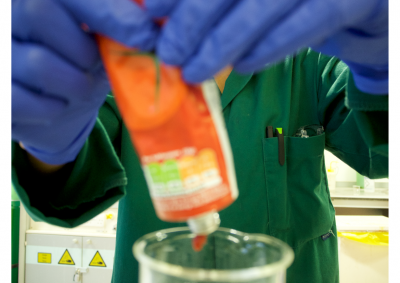DIY chemistry analysis of food
Contents
Aim
The aim of this project is to create a set of protocols to use readily available reagents to extract and test for different micronutrients in foods. The focus is on positive aspects of food - testing for the things that are good for us, rather than testing for contaminants... there's enough fear!
This project is part of the umbrella project Vital.
Context
The protocols listed below are a first step towards making reliable protocols for quantitative testing of micronutrients in food. They need to be tuned and refined in order to determine quantities. Below you'll find links to the development of the protocols documented on PublicLab.
These protocols were tried out in early February 2017 as part of the first year of the Citizen Science for Radical Change: Art, Co-design and Community course at UCL. Students from the course worked with pupils at Newham Sixth Form College, following the protocols below to generate spectra and then discuss questions of how these protocols could be changed and what kind of questions they could answer. Links to spectra can be found in the DIY Chemical Analysis of Food Experimentation Space.
Protocols
Protocols have been laid out for ease of use, with a brief Risk Assessment included.
Use of a DIY Spectrometer for analysis of extracts
The initial research was conducted with a Public Lab Desktop Spectrometry Kit. Subsequent spectrometers were made to a different design. and the spectra analysed using spectralworkbench.
File:SpectrometerAnalysis_layout.pdf
Lycopene from tomatoes
To extract lycopene from tomatoes or tomato paste, you can use engine starter fluid that contains Diethyl Ether. Try to source a starter fluid that has as few ingredients as possible, preferably just a mix of diethyl ether and hexane, to get a clearer spectrum.
Information on the development of the lycopene extraction protocol has been written up as a research note on Public Lab.
File:LycopeneExtraction_layout7_small.pdf
Polyphenols from Grapes
A collection of polyphenols can be extracted from red grapes using surgical spirit - main ingredient ethanol. Some surgical spirits you can buy over the counter contain other ingredients, like castor oil. Castor oil created a cloudy solution when used in this experiment, but the emulsion can be separated by using a centrifuge (which can be a DIY centrifuge or just a long string with the sample securely fastened to the end and then spun at high speed manually).
Information on the development of the phytophenol extraction protocol has been written up as a research note on Public Lab.
File:PolyPhenolsExtractionSmall.pdf
